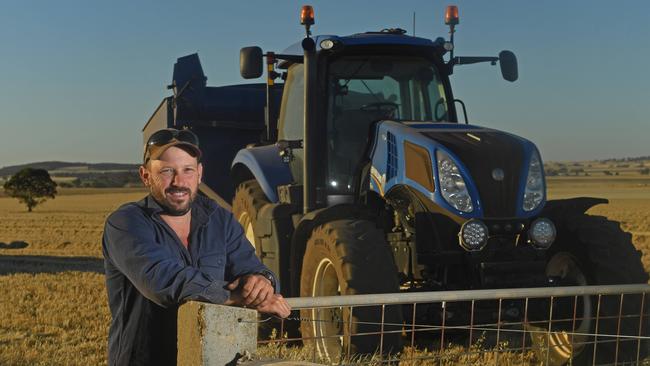SA farmers produce healthy crop yields despite tough year
This season has thrown a range of challenges at the state’s farmers - from drought, to frost - but SA yields have proven to be surprisingly good.

SA Business
Don't miss out on the headlines from SA Business. Followed categories will be added to My News.
- Hay relief comes to drought-hit farmers
- How to get the most out of your Advertiser digital subscription
This year has been a tough one for many South Australian farmers, but despite record low rainfall in some areas, a surprising amount of grain is still being produced in the 2019-20 season.
PIRSA’s final crop and pasture report for the year puts the state’s harvest at 6.25 million tonnes from a sown area of 3.85 million hectares.
This crop estimate is slightly higher than last year’s 5.8 million tonnes but still below the 10 year average of 8 million tonnes.
Just before Christmas, the state’s major grain storage and handling network Viterra had received 3.8 million tonnes of grain into the system.
Viterra chief operations officer James Murray said production volumes this harvest were broadly in line with what was expected.
“From speaking to growers, the overall crop is where we thought it would be going into harvest. While wheat yields are slightly down, that’s been balanced out with better than expected barley yields,” he said.
Mr Murray said a number of farmers across the state ramped up their cropping programs this year.
“The major difference between this year and last year is that more hectares have been planted this year,” he said.
“Last year there was a later break to the season. We didn’t get a major rain until July in 2018 so a lot of crop didn’t go in, particularly near Ceduna and other parts of the western Eyre Peninsula.”
Mr Murray said one of the best aspects to this season was the quality of the grain being produced by SA farmers.
“From a wheat perspective, there’s been higher protein wheat produced across the state,” he said.
“There’s also been a good amount of malt barley produced, versus (lower quality) feed barley.”
Mr Murray said SA farmers had become very good at maximising the moisture available to their crops, helping create solid yields even in tough seasons.
Some of the areas hardest hit by lack of rainfall this year include the eastern Eyre Peninsula and the Mallee.
Frost damage was reported in pockets across the state, including on the Yorke Peninsula, which is quite unusual for the region.
Enjoying good seasonal conditions were the South East, lower Yorke Peninsula and lower Eyre Peninsula.

Viterra sites with the biggest receivals this season were Cummins and Port Lincoln on the lower Eyre Peninsula, Port Giles on the Yorke Peninsula and Bowmans in the Lower North.
“Bowmans actually broke its receival record this year, taking in more than 16,000 tonnes of grain in one day,” Mr Murray said.
Demand for SA grain remains strong, with the domestic market helping offset high global stocks of grain.
“We’re seeing an increasing number of buyers in the system and that’s a real benefit for growers,” Mr Murray said.
Viterra loaded its 100th grain train destined for the east coast in September, and that figure has now hit 136.
“Demand from the east coast hasn’t let up at all, it’s actually increasing,” Mr Murray said.
SA grain is going into multiple districts in Queensland, New South Wales and Victoria, for the milling, malt and feed markets.
Demand from South East Asia and the Middle East for SA grain has also been good, with Viterra reporting strong shipping programs out of Port Lincoln and Thevenard, as well activity ramping up out of Wallaroo and Port Giles at the end of this month.
MORE NEWS
GM ban lifted, but it could be reinstated
Farmers left reeling from Hills fire
To help growers capture the maximum value for their grain, Viterra offered 58 different segregations for different crop types this season.
Kapunda farmer Jarred Tilley said the saving grace to this season had been limited frost compared to 2018.
“Last year we had a really cold winter and then frost all through the spring,” he said.
“The crops this year are outstanding compared to last year, which is amazing considering we had no subsoil moisture leftover from the previous year.
“Hay production in particular has been surprising considering just how tough the year was.”
